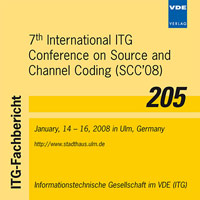On the Design of Double Serially Concatenated Codes with an Outer Repetition Code
Conference: SCC'08 - 7th International ITG Conference on Source and Channel Coding
01/14/2008 - 01/16/2008 at Ulm, Germany
Proceedings: SCC'08
Pages: 6Language: englishTyp: PDF
Personal VDE Members are entitled to a 10% discount on this title
Authors:
Vatta, Francesca (DEEI, Università di Trieste, Trieste, Italy)
Kliewer, Jörg (Klipsch School of Electrical&Computer Engineering, NewMexico State University, Las Cruces, NM, U.S.A.)
Koller, Christian; Costello, Daniel J.; Zigangirov, Kamil Sh. (Dept. of Electrical Engineering, University of Notre Dame, Notre Dame, IN, U.S.A.)
Abstract:
Motivated by the recent discovery that repeat-accumulate-accumulate (RAA) codes with a repetition factor of three or larger are asymptotically good, we focus on the design of double-serially concatenated codes (DSCCs) with an outer repetition code. The main design goal is to obtain rate-1/2 codes with minimum distance approaching the Gilbert-Varshamov bound (GVB), while still maintaining a good convergence threshold with iterative decoding. To this end, the “accumulate” codes, used as middle and inner codes in RAA codes, are replaced with higher memory, rate-1 convolutional codes. We find that distance growth rates close to the GVB can be achieved in a DSCC with code memories as small as two or three. EXIT charts are used to design DSCCs with good convergence thresholds and distance growth properties. Finally, these codes are compared to the RAAA code and a punctured RAA code with a repetition factor of three, both of which exhibit linear distance growth with block length.


